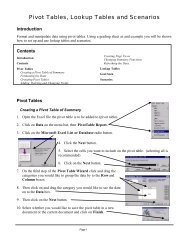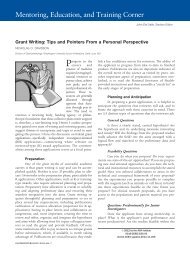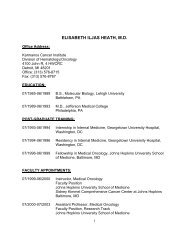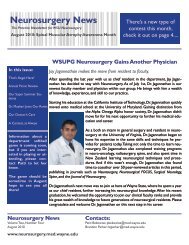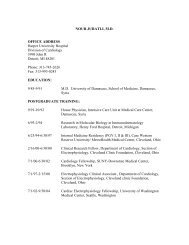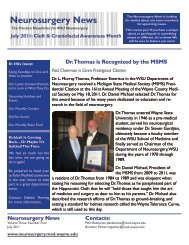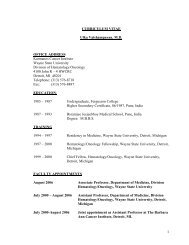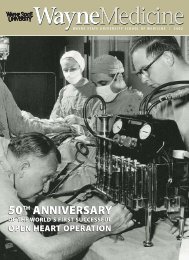Gunshot wounds to the spine. (NM) - Department of Neurosurgery
Gunshot wounds to the spine. (NM) - Department of Neurosurgery
Gunshot wounds to the spine. (NM) - Department of Neurosurgery
Create successful ePaper yourself
Turn your PDF publications into a flip-book with our unique Google optimized e-Paper software.
C.M. Bono and R.F. Heary / The Spine Journal 4 (2004) 230–240 231rifles, such as <strong>the</strong> AK-47 and M-16. In contrast, shotgunsare low-velocity weapons that incur high-energy <strong>wounds</strong> because<strong>of</strong> <strong>the</strong> combined mass <strong>of</strong> <strong>the</strong> numerous fired pellets.In addition, shotgun <strong>wounds</strong> are fur<strong>the</strong>r complicated by <strong>the</strong>presence <strong>of</strong> large pieces <strong>of</strong> “wadding” that are a gross contaminantand require prompt surgical debridement [8].In general, civilian gunshot <strong>wounds</strong> are considered lowenergy. However, an increasing frequency <strong>of</strong> high-energyinjuries is being reported in <strong>the</strong> nonmilitary population [9].Greater availability <strong>of</strong> military-type firearms, especiallyamong <strong>the</strong> criminal element, is a contributing fac<strong>to</strong>r. In1995, assaults with high-energy weapons accounted for 16%<strong>of</strong> homicides in New York City [10]. Close-range gunshotslose less energy during transit and <strong>the</strong>refore transfer moreenergy <strong>to</strong> <strong>the</strong> victim. Differentiation between high- and lowenergyinjuries is crucial, because treatments are distinct.In vivo experiments in monkeys have demonstrated <strong>the</strong>local necrotic effect <strong>of</strong> copper on brain tissue [12]. Similarstudies have been performed on <strong>the</strong> spinal cord. Tindelet al. [13] demonstrated spinal cord necrosis around copperfragments implanted within <strong>the</strong> dura <strong>of</strong> rabbit spinal cords.Whereas lead fragments caused less axonal necrosis thancopper, aluminum resulted in minimal pathologic changes.Importantly, extradural fragments, regardless <strong>of</strong> <strong>the</strong> metaltype, did not cause appreciable pathologic changes within <strong>the</strong>neural tissue. The authors extrapolated that <strong>the</strong>se effectswould be similar <strong>to</strong> those in <strong>the</strong> human spinal cord. Although<strong>the</strong>se findings might support removal <strong>of</strong> intradural copperbullet fragments [14], <strong>the</strong> clinical challenge is determining<strong>the</strong> material <strong>of</strong> <strong>the</strong> bullet, which in many instances is notknown, as well as avoiding fur<strong>the</strong>r neurologic injury duringexplantation. The clinical benefits <strong>of</strong> bullet removal <strong>to</strong> avoid<strong>the</strong> neuro<strong>to</strong>xic effects <strong>of</strong> copper remain unclear.Bullet material and designThe bullet energy is not <strong>the</strong> sole determinant <strong>of</strong> <strong>the</strong> exten<strong>to</strong>f injury. Fragmentation <strong>of</strong> <strong>the</strong> missile can increase <strong>the</strong>zone <strong>of</strong> tissue destruction. Hollow-point bullets explode onimpact, leading <strong>to</strong> multiple fragments that deviate from initiallinear path. The phenomenon <strong>of</strong> yaw refers <strong>to</strong> <strong>the</strong> tumbling<strong>of</strong> a bullet along its longitudinal axis. Longer bulletshave a tendency for greater yaw, which can fur<strong>the</strong>r increase<strong>the</strong> zone <strong>of</strong> destruction. In its mid-path, one can imagine<strong>the</strong> bullet turned 90 degrees <strong>to</strong> its long axis so that it is ineffect being pulled through <strong>the</strong> tissues sideways.Bullets can be nonjacketed, partially jacketed or fullyjacketed. The “jacket” refers <strong>to</strong> a thin metallic layer covering<strong>the</strong> surface <strong>of</strong> <strong>the</strong> bullet. Fully jacketed bullets exhibit littledeformation with firing and are designed for accuracy <strong>to</strong> hitlong-range targets. They are highly precise and incur cleanexit and entrance <strong>wounds</strong>. Partially or nonjacketed missilesexpand on tissue impact and, like hollow-point bullets, exponentiallyextend <strong>the</strong> circumference <strong>of</strong> tissue damage. Suchdesigns are intended for close-range targets.Various materials have been used <strong>to</strong> produce bullets. Mostbullets are composed <strong>of</strong> a lead core, which may be combinedwith a number <strong>of</strong> different metals <strong>to</strong> achieve a desiredhardness. Similarly, <strong>the</strong> jacketing material can be copper,brass or nickel. These substances can have both systemicand local <strong>to</strong>xicities on tissues. More common in synovialjoints, lead poisoning has been reported with bullets lodged in<strong>the</strong> intervertebral disc [11]. Although cerebrospinal fluidwould intuitively be an effective solvent, systemic lead elutionwith intramedullary bullets is uncommon. In cases <strong>of</strong>retained lead bullets, lead levels can be measured periodically.Notwithstanding o<strong>the</strong>r clinical fac<strong>to</strong>rs, significant increasesin lead levels and characteristic hema<strong>to</strong>poieticchanges on bone marrow biopsy can be an indication forbullet removal. In actual clinical practice, bullets very rarelyneed <strong>to</strong> be removed from <strong>the</strong> <strong>spine</strong> <strong>to</strong> treat or preventlead <strong>to</strong>xicity.EvaluationAcute examinationThe initial evaluation <strong>of</strong> <strong>the</strong> gunshot victim must addressall life-threatening injuries. Maintenance <strong>of</strong> airway, breathingand circulation (ABCs) is paramount. The region <strong>of</strong> injuryshould be considered. <strong>Gunshot</strong> <strong>wounds</strong> <strong>to</strong> <strong>the</strong> neck arefrequently complicated by airway injuries that can necessitateemergent intubation [15]. Action should not be delayedfor radiographic “clearance” <strong>of</strong> <strong>the</strong> cervical <strong>spine</strong>, becausegunshot fractures are usually inherently stable [5,16–18].Carotid and vertebral artery perforations should be suspectedwith pulsatile neck bleeding. Immediate vascular consultation<strong>to</strong> res<strong>to</strong>re cerebral blood flow is important, as temporarystents placed emergently can enable definitive repair at alater time. Pharyngeal and esophageal <strong>wounds</strong> must also bedetected and evaluated, because <strong>the</strong>y are <strong>of</strong>ten associatedwith infections. In particular, large hypopharyngeal lacerationsare associated with a higher rate <strong>of</strong> contaminationbecause <strong>of</strong> <strong>the</strong> pooling <strong>of</strong> secretions in this area. Endoscopictechniques can be used effectively and expediently for surveillancein <strong>the</strong> acute setting. Open surgical exploration ismanda<strong>to</strong>ry <strong>to</strong> repair any documented tears.The thoracic <strong>spine</strong> is <strong>the</strong> most commonly affected withgunshots [4]. The lungs, heart and great vessels are at riskwith such injuries. Careful chest auscultation can detectasymmetric breath sounds indicating hemothorax or pneumothorax.Cardiac moni<strong>to</strong>ring, including distal pulses, cansuggest heart perforation, aortic disruption or tamponade.Until stabilization <strong>of</strong> ventilation and hemodynamics, <strong>the</strong>evaluation <strong>of</strong> any spinal injury remains secondary. Similarly,<strong>the</strong> examination <strong>of</strong> <strong>the</strong> abdomen is focused on suspectedvascular or viscus injuries. In particular, colonic perforationsthat occur before <strong>the</strong> missile passing through <strong>the</strong> <strong>spine</strong> mustbe recognized, because <strong>the</strong>y are associated with a high rate<strong>of</strong> spinal infection if not treated with an appropriate antibioticregimen [19–22]. In paraplegic or quadriplegic patients, <strong>the</strong>



